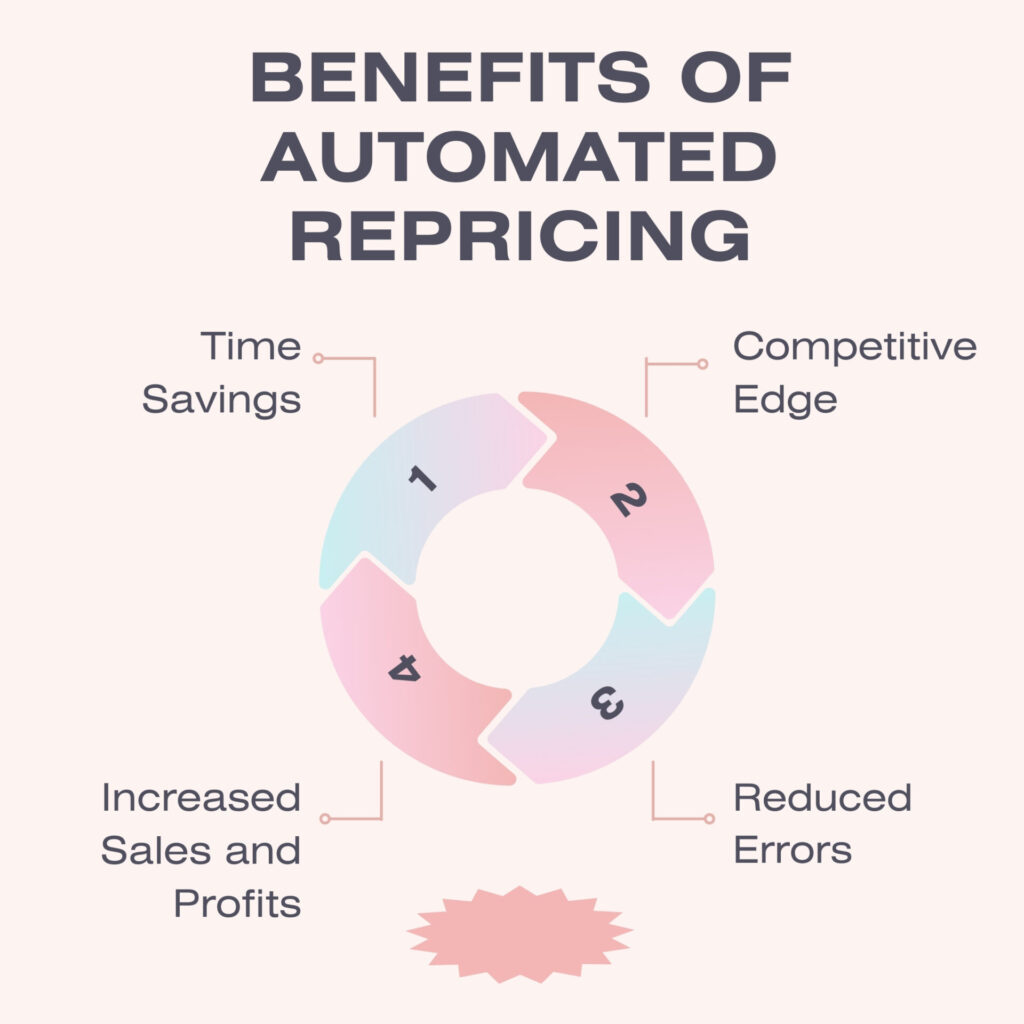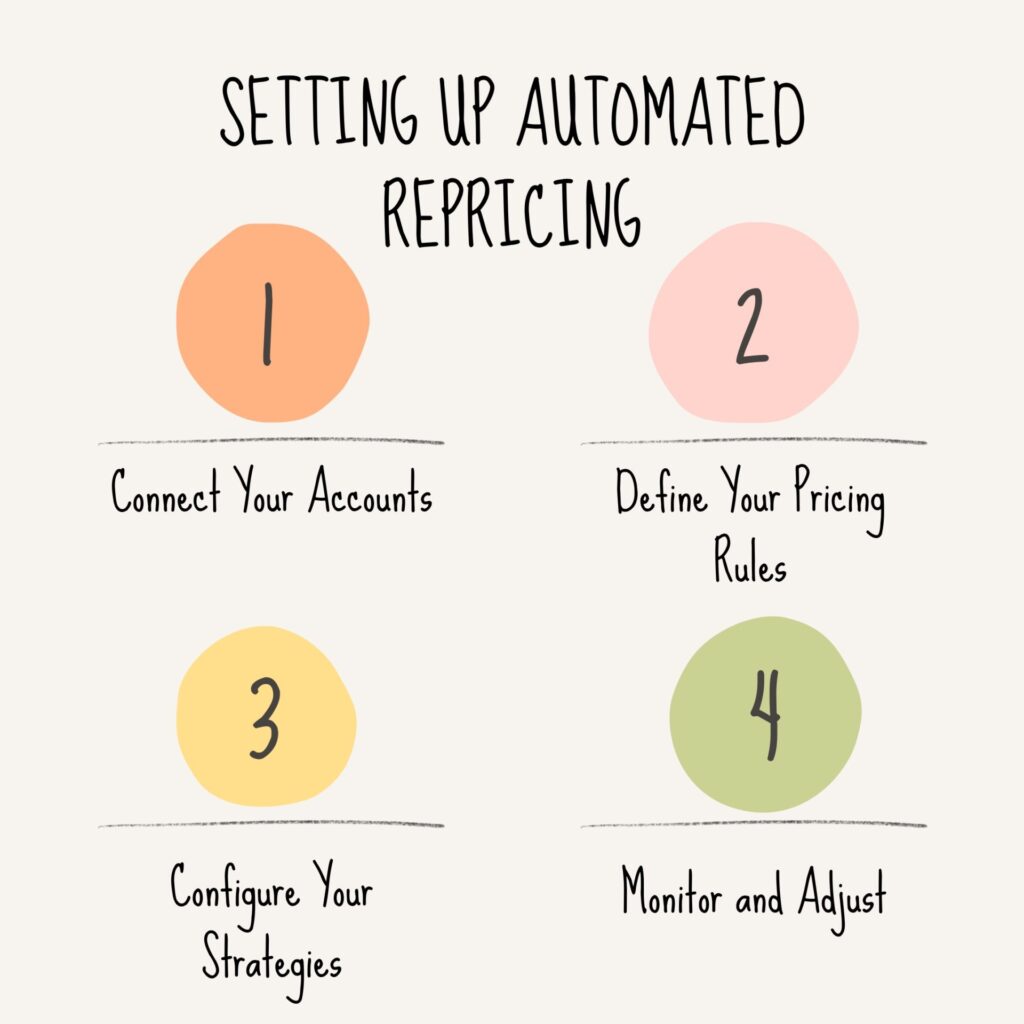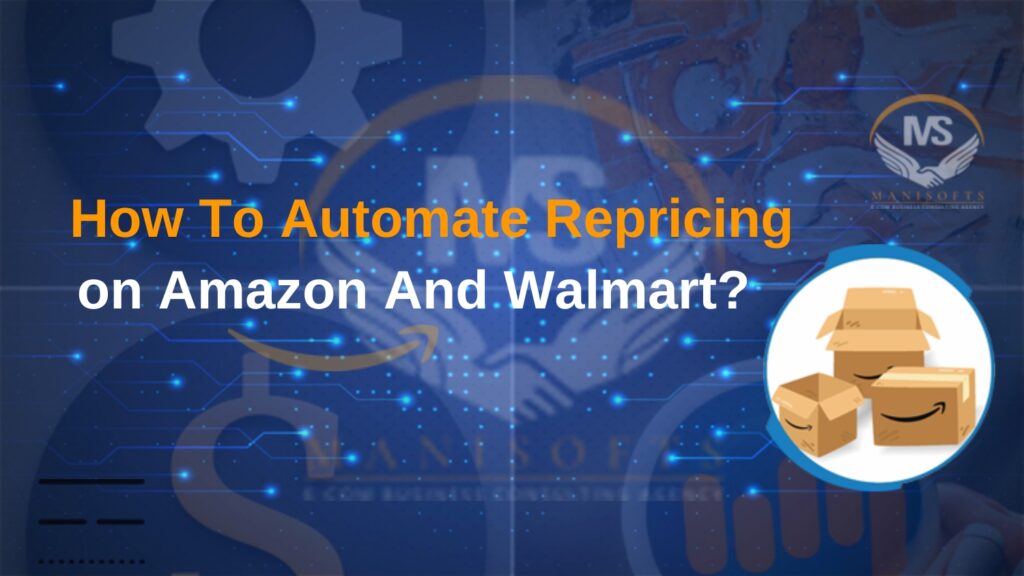Learn how to automate repricing on Amazon and Walmart to stay competitive and boost your sales. Discover effective strategies and tools for dynamic pricing adjustments, ensuring you always offer the best prices and maximize profits.
Introduction
In the competitive world of online retail, pricing strategies can make or break your success on platforms like Amazon and Walmart. Manually adjusting prices to stay ahead of competitors is time-consuming and often ineffective. That’s where automated repricing comes into play. By leveraging advanced tools and algorithms, you can continuously optimize your product prices in real time, ensuring you remain competitive without the constant manual effort. This guide explores the steps and best practices for automating repricing on Amazon and Walmart, helping you enhance your sales performance and increase profitability.
How To Automate Repricing on Amazon And Walmart?
In the competitive e-commerce landscape, sellers must stay vigilant to maintain their edge on platforms like Amazon and Walmart. One of the most effective strategies to achieve this is through automated repricing. This technique ensures that your product prices remain competitive, responsive to market changes, and optimized for profitability. Here’s an in-depth guide on how to automate repricing on Amazon and Walmart.
Understanding Automated Repricing
Automated repricing is a process that utilizes specialized software to adjust the prices of your products automatically. These adjustments are based on a set of predefined rules and strategies that you establish. The software continuously monitors market conditions, competitor prices, and other relevant factors, making real-time adjustments to keep your prices competitive and aligned with your business goals.
Key Features of Automated Repricing Tools
- Real-Time Monitoring: Constantly scans the market for changes in competitor pricing.
- Dynamic Adjustments: Alters prices based on set rules to respond to market fluctuations.
- Comprehensive Analytics: Provides insights and data to inform pricing strategies.
- Customizable Rules: Allows for setting minimum and maximum prices, target profit margins, and competitive positioning.
Benefits of Automated Repricing

1. Time Savings
Manually tracking and adjusting prices across numerous products can be an exhaustive task. Automated repricing tools handle this process efficiently, freeing up valuable time for you to focus on other critical business operations.
2. Competitive Edge
Automated repricing ensures your products are always priced competitively. By quickly adapting to market changes, you can attract more buyers and increase your sales volume.
3. Increased Sales and Profits
By consistently offering competitive prices, you enhance your product’s visibility and appeal to customers. This can increase sales and improved profit margins when combined with smart pricing strategies.
4. Reduced Errors
Human error in manual pricing adjustments can lead to costly mistakes. Automated tools provide accuracy and consistency, reducing the risk of pricing errors that could negatively impact your sales or profits.
Choosing the Right Repricing Tool
Selecting the appropriate repricing tool is crucial for success. Here are some popular options:
1. RepricerExpress
RepricerExpress is known for its user-friendly interface and sophisticated algorithms. It offers comprehensive repricing solutions that cater to both Amazon and Walmart sellers, making it a versatile choice.
2. Informed.co
Informed.co provides dynamic repricing options and detailed analytics. This tool helps sellers make data-driven pricing decisions and adjust prices in response to market trends.
3. SellerActive
SellerActive offers multi-channel repricing, which is particularly useful for sellers managing listings on multiple platforms. This tool ensures consistent pricing strategies across all your sales channels.
4. Feedvisor
Feedvisor uses artificial intelligence to provide smart repricing solutions. It optimizes prices based on market trends and competitor behavior, helping you stay competitive while maximizing profits.
Setting Up Automated Repricing
Here’s a step-by-step guide to setting up your repricing tool:

1. Connect Your Accounts
Link your Amazon and Walmart seller accounts to the repricing tool. This integration allows the tool to access your product listings and pricing data.
2. Define Your Pricing Rules
Establish the parameters for your pricing strategy. These include minimum and maximum prices, desired profit margins, and competitive benchmarks. Your rules should reflect your business goals and market positioning.
3. Configure Your Strategies
Most repricing tools allow you to create multiple strategies for different product categories or market conditions. For instance, you might have one strategy for high-demand items and another for clearance products.
4. Monitor and Adjust
Regularly review the performance of your repricing strategies. Use the detailed analytics the tool provides to understand how pricing changes impact your sales and profits. Adjust your strategies as needed to optimize results.
Best Practices for Automated Repricing
1. Set Clear Goals
Clearly define what you aim to achieve with automated repricing. Whether boosting sales volume, improving profit margins, or maintaining a competitive market position, having clear goals will guide your strategy.
2. Monitor Competitors
Keep an eye on your competitors’ pricing strategies. Understanding their behavior can provide valuable insights and help you adjust pricing rules effectively.
3. Stay Flexible
Market conditions can change rapidly. Be prepared to adjust your repricing strategies in response to shifts in demand, supply, or competitor actions. Flexibility is key to maintaining a competitive edge.
4. Leverage Analytics
Utilize the data and insights provided by your repricing tool to refine your strategies continually. Look for patterns and trends that can inform your pricing decisions and help you stay ahead of the competition.
5. Avoid the Race to the Bottom
While competitive pricing is important, avoid setting low prices to beat competitors. Focus on maintaining healthy profit margins while offering value to your customers. An excessively low price can erode profits and devalue your brand.
Managing and Optimizing Repricing Strategies
Effective management and optimization of repricing strategies are critical for businesses aiming to maintain competitiveness and profitability in dynamic market environments. This involves implementing strategic pricing adjustments and actively monitoring performance, adapting strategies based on analytics and feedback, and effectively addressing pricing errors and issues.
Monitoring Repricing Performance
Continuous monitoring of repricing performance is essential to gauge the effectiveness of pricing strategies and their impact on key business metrics. Here’s how businesses can effectively monitor their repricing efforts:
- Real-time Analytics: Utilize advanced analytics tools to track and analyze key performance indicators (KPIs) such as sales volume, revenue, profit margins, and market share in real-time. This enables businesses to promptly identify the outcomes of repricing decisions and make data-driven adjustments.
- Competitor Benchmarking: Regularly benchmark pricing against competitors to assess market positioning and competitive advantage. Monitoring competitor pricing trends and adjustments provides valuable insights into market dynamics and informs proactive repricing strategies.
- Customer Feedback and Sentiment Analysis: Incorporate customer feedback and sentiment analysis into repricing monitoring. Monitor customer responses to price changes through surveys, reviews, and social media analytics to understand customer perceptions and optimize pricing strategies accordingly.
- Performance Dashboards: Implement performance dashboards that visualize repricing metrics and trends in a clear and actionable format. These dashboards should highlight key metrics, trends over time, and comparative analyses to facilitate informed decision-making.
Adjusting Strategies Based on Analytics and Feedback
Adapting repricing strategies based on analytics and feedback is crucial to maximizing effectiveness and achieving business goals. Here are best practices for adjusting repricing strategies:
- Data-driven Insights: Leverage insights from analytics to identify patterns, trends, and correlations between pricing adjustments and business outcomes. Use predictive analytics to forecast the impact of potential repricing scenarios and optimize strategies proactively.
- Segmentation and Personalization: Tailor repricing strategies based on customer segmentation and preferences identified through data analysis. Segment-specific pricing models enhance relevance and responsiveness to diverse customer needs, driving engagement and loyalty.
- Iterative Testing: Conduct controlled experiments and A/B testing to validate new repricing strategies before full-scale implementation. Test different pricing models, algorithms, and variables to identify optimal approaches that maximize revenue and profitability.
- Agile Adjustments: Maintain flexibility in repricing strategies to respond quickly to changing market conditions, competitive actions, or customer feedback. Agile adjustments based on real-time insights ensure adaptive and effective pricing strategies.
Handling Pricing Errors and Issues
Addressing pricing errors and issues promptly and effectively is crucial to maintaining customer trust and mitigating financial impact. Here’s how businesses can manage pricing errors and issues:
- Proactive Monitoring: Implement automated monitoring systems to detect real-time pricing errors, discrepancies, or anomalies. Prompt detection allows businesses to mitigate risks and minimize the impact on customer experience.
- Transparent Communication: Communicate transparently with customers about pricing errors or discrepancies. Notify affected customers promptly, explain the issue clearly, and provide timely resolutions such as refunds, discounts, or adjustments to uphold trust and satisfaction.
- Root Cause Analysis: Conduct a thorough root cause analysis to identify the underlying reasons for pricing errors or issues. Address systemic issues in pricing processes, systems, or controls to prevent recurrence and improve operational efficiency.
- Continuous Improvement: Establish a feedback loop for continuous improvement in pricing processes and systems based on lessons learned from handling pricing errors. Implement corrective actions and enhancements to strengthen pricing integrity and reliability.
Effectively managing and optimizing repricing strategies requires a proactive approach to monitoring performance, leveraging analytics and customer feedback, and addressing pricing errors promptly and transparently. By adopting best practices in repricing management, businesses can enhance competitiveness, profitability, and customer satisfaction in dynamic market landscapes.
Future Trends in Automated Repricing: Innovations and Predictions
Automated repricing technology has revolutionized how businesses manage pricing strategies, enabling real-time adjustments to optimize competitiveness and profitability. Several innovations are poised to shape the future of automated repricing, offering new capabilities and enhancing strategic decision-making.
Innovations in Repricing Technology
- Machine Learning and AI Integration: Future repricing technologies will increasingly integrate advanced machine learning algorithms and artificial intelligence (AI) to enhance pricing accuracy and responsiveness. AI-powered systems can analyze vast datasets, including historical sales, market trends, competitor pricing, and customer behavior, to predict optimal pricing strategies in real time.
- Dynamic Pricing Algorithms: Next-generation repricing solutions will feature more sophisticated dynamic pricing algorithms. These algorithms will adjust prices based on immediate market conditions and anticipate future trends and consumer demand patterns. By incorporating predictive analytics, businesses can optimize pricing strategies preemptively, maximizing revenue and market share.
- Personalization and Segmentation: Future repricing technologies will prioritize personalization and segmentation capabilities. Advanced data analytics allows businesses to tailor pricing strategies to individual customer preferences, purchase histories, and behavioral insights. Segment-specific pricing models enhance customer engagement and loyalty by offering personalized value propositions.
- Real-time Market Monitoring: Enhanced real-time monitoring capabilities will enable businesses to instantaneously track competitor pricing changes, market fluctuations, and consumer sentiment. Automated alerts and notifications will empower businesses to respond swiftly to competitive threats or market opportunities, ensuring agility in pricing decisions.
- Integration with IoT and Big Data: Integrating Internet of Things (IoT) devices and big data analytics will further expand the scope of automated repricing. IoT sensors can provide real-time data on inventory levels, supply chain dynamics, and customer foot traffic, enabling dynamic pricing adjustments based on actual operational conditions.
Predictions for the Future of Automated Repricing
- Increased Adoption Across Industries: As automated repricing technologies become more sophisticated and accessible, their adoption will expand across diverse industries beyond retail, including e-commerce, travel, hospitality, and beyond. Small to large enterprises will leverage automated repricing to gain competitive advantages and improve operational efficiency.
- Emphasis on Ethical Pricing Practices: With growing consumer awareness and regulatory scrutiny, future repricing technologies will emphasize ethical pricing practices. Transparent algorithms, fair pricing policies, and compliance with regulatory guidelines will be paramount to maintaining trust and loyalty among customers and stakeholders.
- Augmented Decision Support: Repricing technologies of the future will not only automate pricing adjustments but also provide augmented decision support tools. Interactive dashboards, predictive analytics models, and scenario planning capabilities will empower businesses to make informed, data-driven pricing decisions aligned with strategic objectives.
- Integration with Omnichannel Strategies: Future repricing technologies will seamlessly integrate with omnichannel sales and marketing strategies. Unified pricing across online platforms, brick-and-mortar stores, mobile apps, and social media channels will ensure consistent customer experiences and optimize revenue generation opportunities.
- Continuous Innovation and Adaptation: In an increasingly competitive marketplace, continuous innovation will drive the evolution of automated repricing technologies. Adaptive algorithms, real-time feedback loops, and iterative improvements will enable businesses to stay ahead of market trends, customer preferences, and technological advancements.
Technological advancements, predictive capabilities, and ethical considerations characterize the future of automated repricing. Businesses that embrace these innovations can anticipate greater agility, profitability, and customer satisfaction in an evolving global economy.
FAQ’s
Generally, choosing a reputable tool and setting your pricing rules carefully is safe. However, it’s important to understand the platform’s terms of service regarding automation.
It’s unlikely that your repricing strategy is fair and doesn’t engage in manipulative practices. However, always prioritize following platform guidelines.
Pricing varies depending on the tool and features offered. Most services offer tiered pricing plans based on monthly fees or transaction volume.
Potential downsides include price wars with competitors, accidentally setting unprofitable prices, and relying too heavily on automation without considering market trends.
Set clear minimum and maximum price limits.
Monitor your repricing rules and adjust them as needed.
Consider factors beyond competitors’ prices, like profit margin and product demand.
Conclusion
Automating repricing on Amazon and Walmart is a powerful strategy for online sellers aiming to stay competitive in dynamic marketplaces. By implementing automated repricing tools, sellers can adjust their prices in real time based on market conditions, competitor pricing, and demand fluctuations. This helps maintain optimal pricing and maximises profits and sales velocity.
Automated repricing solutions can save time and reduce manual effort, allowing sellers to focus on other aspects of their business, such as inventory management and customer service. With the right repricing software, sellers can set rules and parameters that align with their business goals, ensuring they remain competitive without sacrificing profitability. Ultimately, leveraging automation in repricing helps sellers navigate the complexities of e-commerce with greater efficiency and success.




